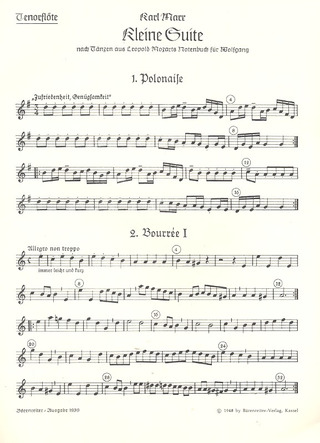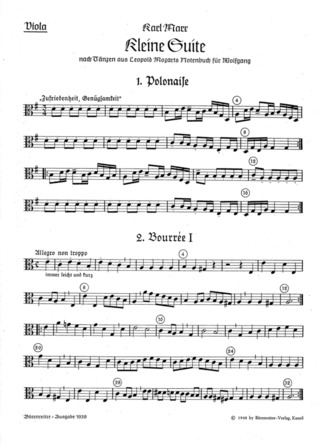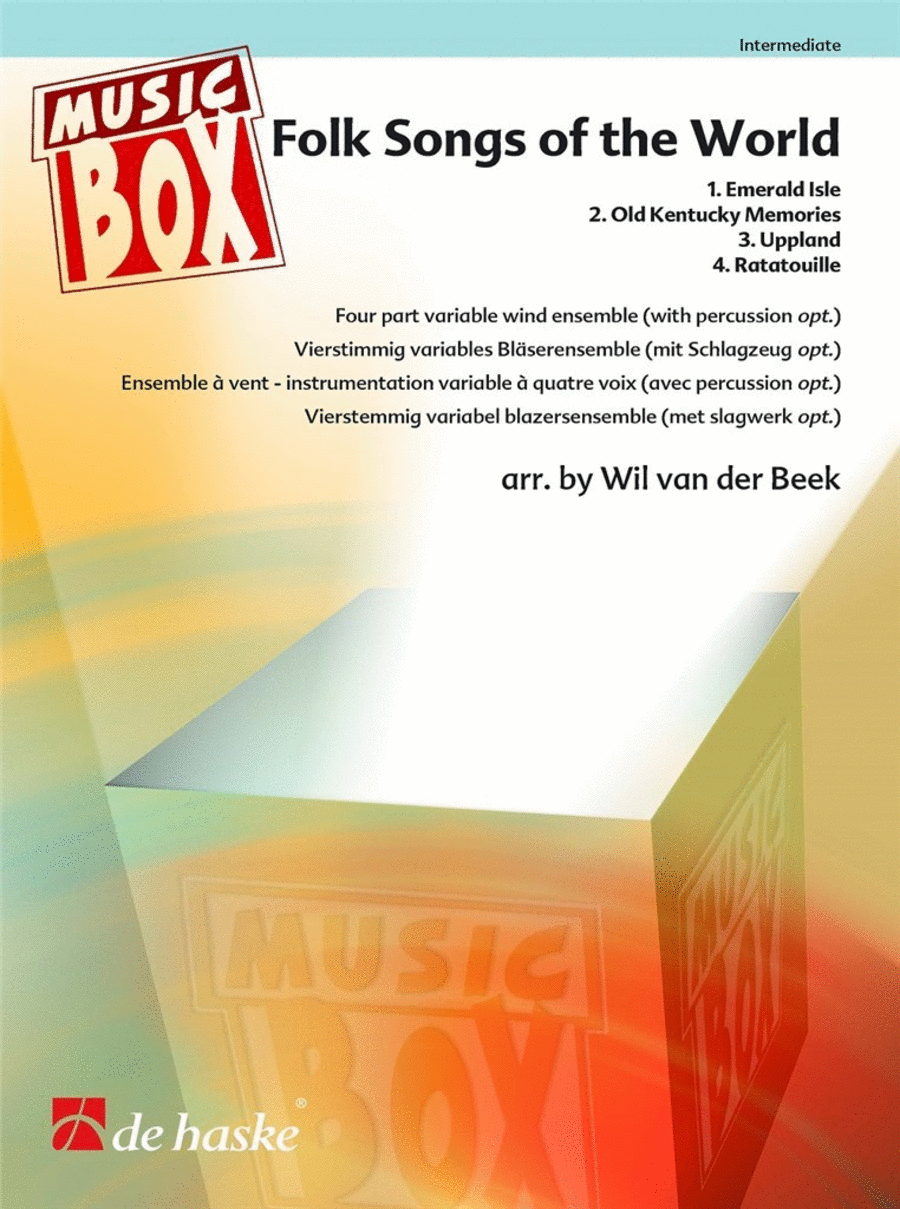|
| English Dances, Set 1, Op. 27: No. 1
Ensemble de cuivres [Conducteur] - Intermédiaire
De Haske Publications
Brass Band - Grade 4 SKU: BT.DHP-1206265-130 Andantino. Composed b...(+)
Brass Band - Grade 4
SKU:
BT.DHP-1206265-130
Andantino.
Composed by Sir Malcolm
Arnold. Arranged by Ray
Farr. Great Classics.
Classical. Score Only.
Composed 2020. 12 pages.
De Haske Publications
#DHP 1206265-130.
Published by De Haske
Publications
(BT.DHP-1206265-130).
English
Dances, Set I, opus
27, is a light
classic composition that
was written for orchestra
by the British composer
Malcolm Arnold in 1950.
The set contains four
dances that continue
without pause: the
individual movements are
indicated by the tempo
markings. The work came
about at the request of
Bernard de Nevers, at the
time the head of
publisher Alfred Lengnick
& Co., who asked Arnold
to write a suite of
dances as an English
counterpart to Dvo
ák’s Slavonic
Dances and
Bartók’s
Romanian Folk Dances. The
première took place in
the spring of 1951,
played by the London
Philharmonic Orchestra,
conducted by Sir Adrian
Boult. Following the
success of the first set,
DeNevers asked the
composer to write a
second one, which Arnold
completed the next year
(Op. 33). The
Andantino from the
first set has been
skilfully arranged and
orchestrated for brass
band by Ray Farr.
English
Dances, Set I, opus
27, is een licht
klassieke compositie die
in 1950 door de Britse
componist Malcolm Arnold
voor orkest geschreven
werd. De set bestaat uit
vier dansen die zonder
onderbreking in elkaar
overgaan: de
afzonderlijke delen
worden aangegeven met de
tempomarkering. Het werk
kwam tot stand op verzoek
van Bernard de Nevers,
destijds het hoofd van
uitgeverij Alfred
Lengnick & Co., die
Arnold vroeg om een reeks
dansen te schrijven als
een Engelse tegenhanger
voor de Slavische dansen
van Dvo ák en de
Roemeense volksdansen van
Bartók. De première
werd in het voorjaar van
1951 gebracht door het
London Philharmonic
Orchestra, onder leiding
van Sir Adrian Boult.Na
het succes van de eerste
set vroeg De Nevers om
een tweede, die Arnold
een jaar later voltooide
(opus 33). Het
Andantino uit de
eerste set is door Ray
Farr meesterlijk
gearrangeerd en ge
nstrumenteerd voor
brassband.
English
Dances, Set I, opus
27, ist eine leicht
Klassische Komposition,
die 1950 von dem
britischen Komponisten
Malcolm Arnold für
Orchester geschrieben
wurde. Die Reihe
enthält vier Tänze,
die ohne Unterbrechung
gespielt werden. Die
einzelnen Sätze sind
mit Tempoangaben
versehen. Das Werk
entstand auf Wunsch von
Bernard de Nevers, dem
damaligen Leiter des
Verlags Alfred Lengnick &
Co., der Arnold bat, eine
Reihe von Tänzen als
englisches Gegenstück
zu Dvo áks Slawischen
Tänzen“ und
Bartóks Rumänischen
Volkstänzen“ zu
schreiben. Die
Uraufführung fand im
Frühjahr 1951 mit dem
London Philharmonic
Orchestra unter der
Leitung von Sir Adrian
Boult statt. Nach
demErfolg der ersten
Reihe bat de Nevers den
Komponisten, eine zweite
Reihe zu schreiben, die
Arnold im darauffolgenden
Jahr fertigstellte (op.
33). Das Andantino
aus der ersten Reihe
wurde von Ray Farr
gekonnt für Brass Band
arrangiert und
orchestriert.
English
Dances, Set I, opus
27, est une
composition de musique
légère classique
pour orchestre écrite
en 1950 par le
compositeur britannique
Malcolm Arnold. La
série comprend quatre
danses qui
s’enchaînent
sans interruption, les
divers mouvements
étant indiqués par
des changements de tempo.
Cette Å“uvre fut
écrite la demande de
Bernard de Nevers, alors
directeur de
l’éditeur
Alfred Lengnick & Co.,
qui pria Arnold de
composer une série de
danses qui serait
l’équivalent
anglais des Danses slaves
de Dvo ák et des
Danses populaires
roumaines de Bartók.
L’œuvre fut
créée le 14 avril
1951 par le London
Philharmonic Orchestra
sous la direction de Sir
Adrian Boult. la suite du
succès de la
première série, De
Nevers pria le
compositeur d’en
écrire une seconde,
qui fut achevée
l’année
suivante (Op. 33).
L’Andantino
de la première
série a été
habilement arrangé et
orchestré pour brass
band par Ray Farr. $21.95 - Voir plus => AcheterDélais: 2 to 3 weeks | | | |
| Folk Songs of the World [Conducteur et Parties séparées] - Intermédiaire
De Haske Publications
4 Part Variable Wind Ensemble with Percussion - intermediate SKU: BT.DHP-1216...(+)
4 Part Variable Wind
Ensemble with Percussion
- intermediate SKU:
BT.DHP-1216326-070
Arranged by Wil van der
Beek. Music Box. Folk
Music. Set (Score &
Parts). Composed 2021. De
Haske Publications #DHP
1216326-070. Published by
De Haske Publications
(BT.DHP-1216326-070).
ISBN 9789043162067.
English-German-French-Dut
ch. 1. Emerald
Isle, in this part, the
musical spotlight focuses
in on the green island of
Ireland and its great
wealth of traditional
folk music. The piece
opens with the air
‘My Lodging Is on
the Cold Ground’,
also known under the
title ‘Believe Me,
If All Those Endearing
Young Charms’
(bars 5-24). Next, we
hear another well-known
air ‘The Minstrel
Boy’ (bars 29-44).
Finally, the air
‘The Groves of
Blarney’, possibly
better known as
‘The Last Rose of
Summer’ (bars
53-68) is heard. Each air
is heralded by a short
introduction and brought
to an end by a short
conclusion. 2. Old
Kentucky Memories,
following an introduction
of 14 bars all attention
is claimed by the song
‘My Old Kentucky
Home’. As the
piece goes on, snippets
of memories emerge,
fleetingly, surfacing
fast, but quickly
disappearing again: this
is musically featured by
way of small motifs and
themes from other songs.
These can be heard
briefly, and then they
disappear, musing on Old
Kentucky until the
introduction returns to
end the piece. 3.
Uppland, is a province in
Sweden that had a rich
folk music culture, like
the whole of Sweden, that
boasts many songs and
dances. A notable amount
of these songs and dances
have been composed in
minor keys, three of
which feature in this
part. First, we hear
‘Svensk
folkvisa’(bars
1-38), followed by the
famous
‘Värmlandsvisan�
�€™ (bars 39-67) and
then brought to an end by
‘Vexelsang’
(bars 68-end). 4.
Ratatouille, in this
part, no folk songs of
just one country or one
province are featured.
This piece is a mishmash
(or ratatouille), a
hotchpotch of three folk
songs with no significant
relation at all. In
succession, we hear a
song from Russia (bars
1-30), one from Japan
(bars 31-58) and one from
Australia (bars 59-end).
The composer of the
Russian song titled
‘The
Nightingale’ is
Alexander Alyabyev (1787
1851), but the composers
of the Japanese song
titled
‘Sakura’ and
the Australian
‘Waltzing
Matilda’ are
unknown.
1.
Emerald Isle, in dit deel
zijn de muzikale
schijnwerpers gericht op
het groene eiland
Ierland, op de grote
rijkdom aan traditionele
volksmuziek. Het werkje
opent met de air
‘My Lodging Is on
the Cold Ground’,
ook bekend onder de titel
‘Believe Me, If All
Those Endearing Young
Charms’ (maat
5-24). Daarna volgt de
bekende air ‘The
Minstrel Boy’
(maat 29-44). En ten
slotte horen we nog de
air ‘The Groves of
Blarney’,
misschien beter bekend
als ‘The Last Rose
of Summer’ (maat
53-68). Elke air wordt
voorafgegaan door een
korte inleiding en
beëindigd met een
korte afsluiting. 2. Old
Kentucky Memories, na een
inleiding van 14 maten
(deels ook als afsluiting
van dit deel gebruikt)
wordt alle aandacht
opgeëist door de song
‘My Old Kentucky
Home’. Al gauw
doemen er echter flarden
van herinneringen op,
vluchtig, snel opkomend,
maar ook weer snel
verdwijnend: dit krijgt
muzikaal gestalte door
middel van motiefjes en
thema’s uit andere
songs. Deze zijn even
hoorbaar en dan weer vlug
verdwenen... Mijmeren
over Old Kentucky dus...
3. Uppland, is een
provincie in Zweden met
een rijke muziekcultuur,
zoals heel Zweden
trouwens ruim bedeeld is
met volksliederen en
volksdansen. Opvallend
veel van deze liederen en
dansen zijn gecomponeerd
in mineurtoonsoorten. Dit
is ook het geval met de
drie voor dit deel
uitgekozen songs: als
eerste ‘Svensk
folkvisa’(maat
1-38), gevolgd door het
bekende
‘Värmlandsvisan�
�€™ (maat 39-67) en
tot besluit
‘Vexelsang’
(maat 68-slot). 4.
Ratatouille, in dit deel
worden geen volksliedjes
van één land of
één provincie
belicht. Dit werkje is
een
‘ratjetoe’
(ratatouille), een
allegaartje van drie
folksongs die onderling
geen enkel verband met
elkaar hebben: de enige
overeenkomst is dat ze
alle drie als volksmuziek
bestempeld kunnen worden.
Achtereenvolgens klinkt
er een lied uit Rusland
(maat 1-30), uit Japan
(maat 31-58) en uit
Australië (maat
59-slot). Van het
Russische lied met de
titel ‘De
nachtegaal’ is de
componist bekend: dat is
Aleksandr Aljabjev (1787
1851). Van het Japanse
lied
‘Sakura’ en
de Australische song
‘Waltzing
Matilda’ kennen we
niet de componist
niet.
1. Emerald
Isle, in diesem Abschnitt
richtet sich die
musikalische
Aufmerksamkeit auf die
grüne Insel Irland mit
ihrem großen Reichtum
an traditioneller
Volksmusik. Das Stück
beginnt mit der Melodie
My Lodging Is on the Cold
Ground“, auch
bekannt unter dem Titel
Believe Me, If All Those
Endearing Young
Charms“ (Takt
5-24). Anschließend
erklingt die bekannte
Melodie The Minstrel
Boy“ (Takt 29-44).
Schließlich ist The
Groves of Blarney“,
vielleicht bekannter
unter dem Titel The Last
Rose of Summer“
(Takt 53-68), zu
hören. Jede Melodie
wird durch eine kurze
Einleitung angekündigt
und mit einem kurzen
Nachspiel beendet. 2. Old
Kentucky Memories, nach
einer 14 Takte dauerndern
Einleitung tritt das Lied
My Old Kentucky
Home“ in den
Mittelpunkt. Im weiteren
Verlauf des Stücks
erscheinen
bruchstückhafte
Erinnerungen, die fast so
schnell wieder
verschwinden, wie sie
auftauchen. Dies wird
musikalisch durch kleine
Motive und Themen aus
anderen Liedern
dargestellt. Diese sind
kurz zu hören und
verschwinden dann,
während man über
Old Kentucky nachdenkt,
bis die Einleitung wieder
erklingt, die zum Schluss
des Stückes führt.
3. Uppland, ist eine
schwedische Provinz, die
wie ganz Schweden eine
reiche Volksmusikkultur
mit vielen Liedern und
Tänzen hat. Eine
große Anzahl der
Lieder und Tänze, von
denen drei in diesem
Abschnitt enthalten sind,
stehen in Moll-Tonarten.
Zuerst hören wir
Svensk folkvisa“
(Takt 1-38), darauf
erklingt das berühmte
Värmlandsvisan“
(Takt 39-67) und am Ende
Vexelsang“ (Takt
68-end). 4. Ratatouille,
in diesem Abschnitt
werden nicht die
Volkslieder eines
einzigen Landes oder
einer einzigen Provinz
vorgestellt, sondern das
Stück ist ein Mischung
(oder Ratatouille“)
aus drei Volksliedern,
die keinerlei Beziehung
zueinander haben.
Zunächst erklingt ein
Lied aus Russland (Takt
1-30), dann eines aus
Japan (Takt 31-58) und
zum Schluss eines aus
Australien (Takt
59-Ende). Der Komponist
des russischen Liedes mit
dem Titel The
Nightingale“ ist
Alexander Alyabyev (1787
1851). Die Komponisten
des japanischen Liedes
Sakura“ und der
australischen Melodie
Waltzing Matilda“
sind unbekannt.
1.
Emerald Isle (ÃŽle
d’émeraude),
cette première partie
met en vedette la
verdoyante île
d’Irlande et son
riche patrimoine de
musique folklorique
traditionnelle. Elle
s’ouvre avec «
My Lodging Is on the Cold
Ground », un air
également connu sous
le titre « Believe Me,
If All Those Endearing
Young Charms »
(mesures 5-24). Vient
ensuite un autre air
célèbre, « The
Minstrel Boy »
(mesures 29-44),
lui-même suivi de «
The Groves of Blarney
», peut être mieux
connu sous le titre «
The Last Rose of Summer
» (mesures 53-68).
Chaque air est annoncé
par une courte
introduction et
s’achève avec
une courte conclusion. 2.
Old Kentucky Memories
(Souvenirs du vieux
Kentucky), après une
introduction de 14
mesures, toute
l’attention se
porte sur la chanson «
My Old Kentucky Home
». A fil de la
pièce, des fragments
de souvenirs fugaces
émergent,
disparaissant aussi vite
qu’ils se
présentent : cette
impression est
créée par le biais
de courts motifs et
thèmes empruntés
d’autres chansons.
On les entend
brièvement puis ils
s’estompent, comme
de lointains souvenirs du
vieux Kentucky,
jusqu’ une reprise
de l’introduction
pour conclure la
pièce. 3. Uppland, est
une province suédoise
aux riches traditions
musicales, tout comme
l’ensemble de la
Suède, qui compte de
nombreuses danses et
chansons. Beaucoup sont
en tonalité mineure,
et cette partie en
comprend trois. La
première est «
Svensk folkvisa »
(mesures 1-38), qui est
suivie de «
‘Värmlandsvisan
» (mesures 39-67), et
la pièce
s’achève avec
« Vexelsang »
(mesure 68 jusqu’
la fin). 4. Ratatouille,
cette dernière partie
ne comprend pas
d’air provenant
d’un seul pays.
C’est un
méli-mélo, une «
ratatouille » de trois
chansons folkloriques
sans aucun lien. Il y a
d’abord une
chanson russe, « Le
Rossignol » (mesures
1-30), puis « Sakura
», originaire du Japon
(mesures 31-58) et,
enfin, « Waltzing
Matilda », venue
d’Australie
(mesure 59 jusqu’
la fin). La chanson russe
est d’Alexander
Alyabyev (1787-1851),
mais nous ignorons les
auteurs des deux autres
chansons. $36.95 - Voir plus => AcheterDélais: 2 to 3 weeks | | |
|



















